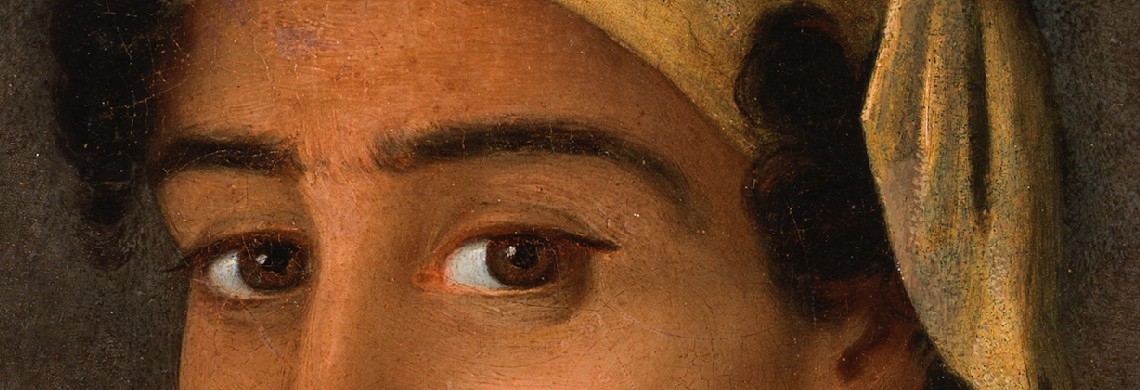Ever since the reopening of the French Quarter Galleries this past fall, a new text panel has accompanied one of THNOC’s rarest artworks, an 1837 oil painting by the New Orleans artist François Fleischbein. It depicts a woman of color with a modest smile. She wears a golden tignon (headwrap), earrings, and an elaborate, tiered lace collar and golden bow over a black frock.
As the text panel explains, for 30 years, the painting bore a different aspect—the result of a bad conservation job performed in 1988 after the painting’s 1985 acquisition. The conservator—Phyllis Hudson, an outside party hired by THNOC and well regarded in the local fine art community—decided that the sitter’s ornate collar and bow were not original to the painting. Without THNOC’s permission, she removed the lace ruff, as well as the bow, leaving a plain white collar in their stead.
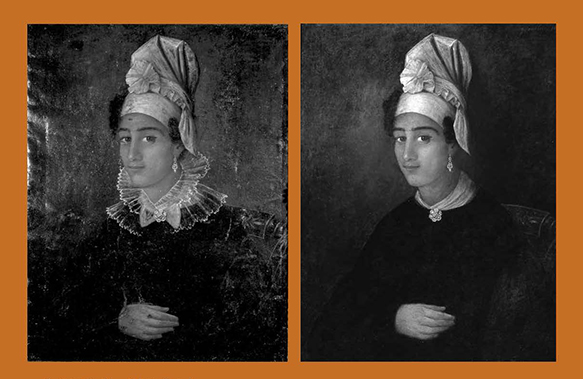
In 1985 THNOC acquired the Fleischbein portrait, seen at left in its original state upon purchase, and subsequently contracted with conservator Phyllis Hudson to remove layers of dust and grime that had accumulated over the years, as well as to treat the cupping and buckling seen on the canvas. Hudson returned the painting in 1988 (right) with the sitter’s lace ruff and bow removed. (THNOC, 1985.212)
THNOC curators feared incurring further damage to the painting by seeking a restoration. And so, for decades, the portrait was exhibited in its altered state. Visitors to the museum might have heard the story of the tragic conservation from a docent, but THNOC did not disclose the mistake in any official capacity.
Moreover, for a period of time THNOC adopted a theory about the identity of the sitter—that she was the artist’s housekeeper, Betsy—even though that identification had not been directly substantiated. That interpretation, as well as Hudson’s denial of the authenticity of the sitter’s adornments, seemed predicated on cavalier assumptions about the sitter’s race and class. The subtext was that a woman of color at that time simply could not have worn such finery. “Our display and interpretation of the work made us complicit in the erasure of the sitter’s identity and dignity,” the new text panel states.
In 2016 Craig Crawford, a conservator new to town, heard the story about the portrait while touring THNOC. Looking at the painting, he remarked that it would have been difficult to remove the original white paint of the collar; he surmised that, instead, Hudson had “overpainted” the newer collar and that the original lay beneath.
He was right. After three decades, the portrait was returned to its original state and is on view once again.
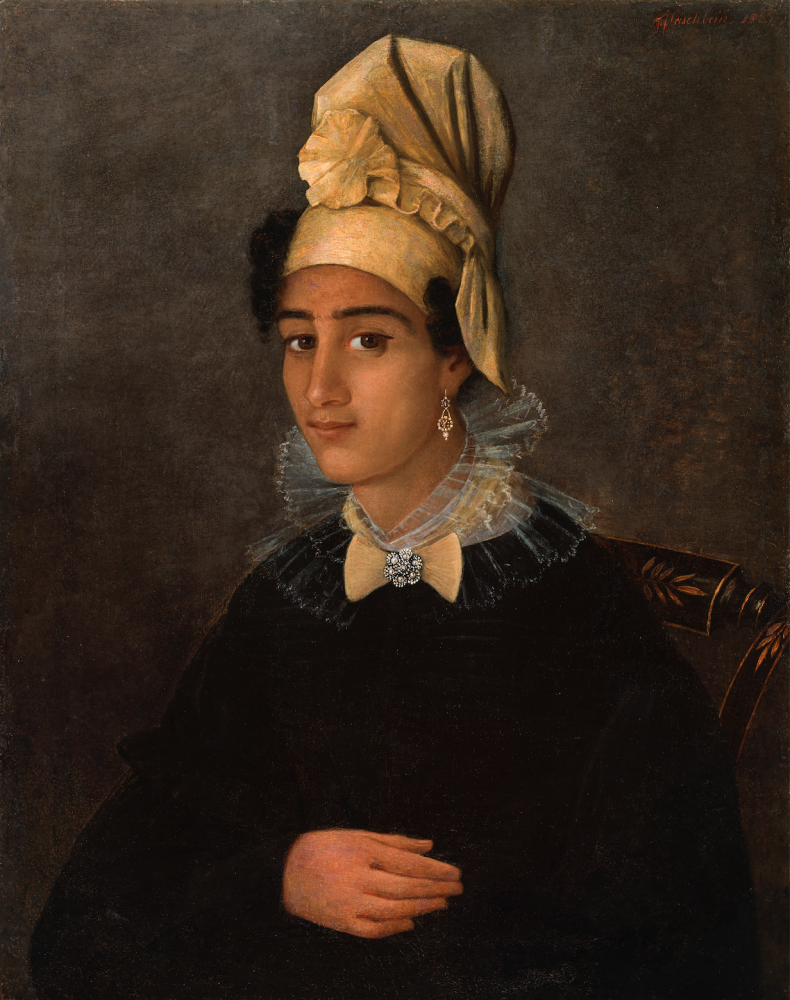
In 2016 conservator Craig Crawford used a microscope and a blacklight to examine the painting, confirming his suspicion that the original collar had not been removed at all but had instead been painted over. In 2017 he removed the collar Hudson had added and restored the painting to the artist’s original vision. (THNOC, 1985.212)
The story of this erasure and its fortunate reversal has been a complicated one for The Collection, prompting us to reexamine our approach to conservation, our awareness of implicit bias in interpreting our holdings, and our disclosure of sensitive information. Hudson’s actions misrepresented the sitter as Fleischbein saw her; by not publicly discussing the portrait’s history, THNOC extended the arc of that misrepresentation.
“It was not clear for so long, simply by looking at the painting in our museum, what it truly was,” says THNOC President/CEO Daniel Hammer. “That is part of the history of the painting, its decades in our care. It’s a public part of it as well: when it was in our museum, it was a tool for the public to learn about the past, but it did not do so truthfully. That’s something that we felt we had to explain with this new interpretation panel.
“This is a story that has real impact. It’s part of a long history of perpetuating misunderstanding about the role of people of color in this country and their contributions to society.”
A robbery
Today, Judith H. Bonner is THNOC’s senior curator of art, but in May 1988 she was a junior staffer less than one year into the job when her supervisor, Curator of Art John Mahé, received a call from Phyllis Hudson about the conservation of the Fleischbein painting. The portrait had been in her care for about 19 months by that point, and Mahé had resorted to issuing “polite ‘threats’” warning Hudson that if she did not return the painting soon he would come and pick it up himself. Hudson called to give Mahé a progress report and mentioned that she intended to remove the sitter’s lace collar and bow.
“John came in in a real flurry—upset,” Bonner recalls.
Mahé asked Hudson to wait until they had a chance to consult a key piece of evidence: Fleischbein’s sketchbook, on loan at the time to the New Orleans Museum of Art. Mahé directed Bonner to go there first thing in the morning, and she found the artist’s original sketch from which he painted the portrait. “I looked at the drawing, and the collar was there,” Bonner says. “It wasn’t as ornate as what Fleischbein put in his final version, but that’s common. As any artist is working from pencil to paint, it’s going to change.”
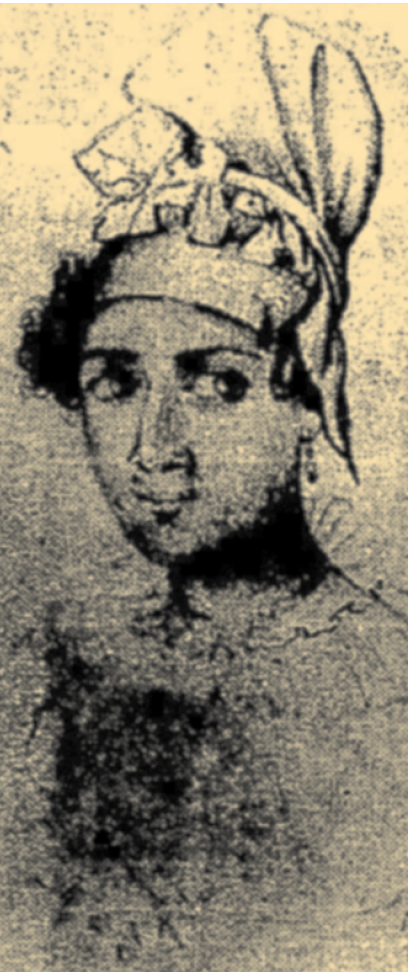
Artist François Fleischbein made this pencil sketch of his sitter prior to committing the portrait to canvas. The sketch features the tiered lace ruff of the sitter’s collar, proving that it was indeed original to the painting. (Courtesy of NewsBank)
Bonner immediately called Mahé to let him know that the lace collar must indeed be original to the painting. But when Mahé called Hudson with the confirmation, she informed him that she had already removed it and the bow.
“Everybody was upset,” Bonner recalls. “She [the sitter] had a social standing that was obvious from that collar and jewelry and the tignon. What Phyllis did, it robbed her of her social standing.”
A silent victim
The unknown identity of Fleischbein’s sitter has been a source of speculation, conjecture, and outright myth since long before THNOC acquired the painting. “For years she had been rumored to be the infamous voodoo queen Marie Laveau,” writes art historian Lucia Olubunmi R. Momoh in a 2017 Iron Lattice article about the painting and THNOC’s stewardship of it. Mahé refers to this rumor in a 1988 memo: “Not believing this fable,” he writes, “The Collection purchased it [the painting] after recognizing it to be one of only four extant antebellum portraits of a Black woman” known to exist at the time.
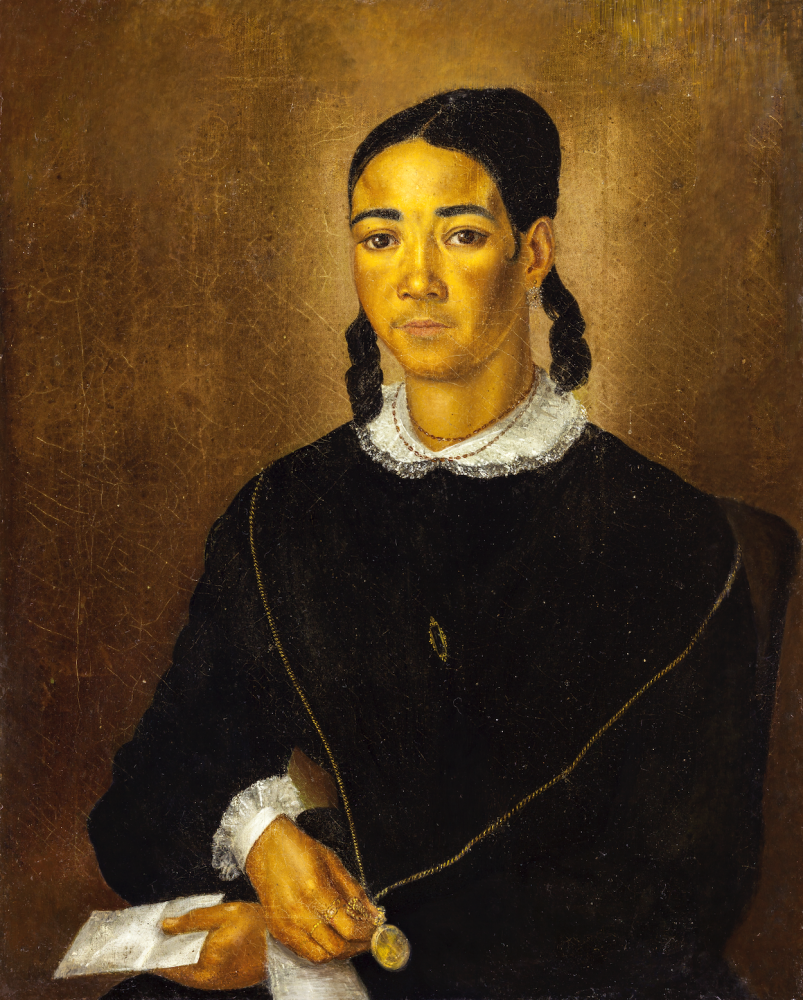
This 1830s portrait, held by the New Orleans Museum of Art, is another Fleischbein painting that depicts a free woman of color. Like the sitter of THNOC’s Fleischbein portrait, the identity of this sitter is also unknown. (Courtesy of the New Orleans Museum of Art, gift of William E. Groves, 66.29)
Another theory came from a 1976 Times-Picayune article written by New Orleans art critic and collector George Jordan, who had been able to study two of Fleischbein’s sketchbooks, then held by the artist’s great-grandchildren. In the article, Jordan mentions the drawing—the same one Bonner later consulted to confirm the lace collar’s authenticity—and theorizes that the sitter belonged to Fleischbein and his wife: “probably their slave, Betsy.”
Sanchez Antiques and Auction Galleries, which sold the artwork to The Collection in 1985, described it as “oil ptg. of young woman Quadroon dressed in her finery topped with a tignon.”
As Momoh has written, both in her Iron Lattice piece as well as her 2019 master’s thesis for Tulane University, these three presumptive identifications—slave, quadroon, and voodoo priestess—all represent different tropes attached to women of color throughout history. The servile slave, the hypersexed quadroon or “tragic mulatto,” and the exotic voodoo queen are all racial lenses through which history has viewed these women of the past. The truth, however, especially in as demographically complex a place as early 19th-century New Orleans, is often more complicated.
“I personally thought she was a free woman of color employed as a high-level housekeeper, and she was clearly being paid,” Bonner says. “How could you afford a beautiful pleated lace collar and a tignon like that without money? So to me, it was clear that she was not a servant, with the connotations that word entails, but a housekeeper.”
Others believe that the wealth displayed in her jewelry and collar indicate that she was not under anyone’s employment at all; perhaps she was one of the many free-women-of-color landowners in 19th-century New Orleans. “While some free women of color participated in New Orleans’s economy as nannies, tutors, seamstresses, housekeepers, and landlords, most of these women could still not have afforded a formal portrait by François Fleischbein, nor the elegant gold-leaf frame,” Momoh writes in her thesis.
A half-truth
The sitter’s collar and bow were not simply adornments; they were important clues about her identity, and Hudson’s tampering had erased them. THNOC curators felt limited in their options going forward. Two days after his phone call with Hudson, Mahé drafted a memo to THNOC’s board detailing the incident and calling on the institution to sever its professional relationship with Hudson, as well as to report her to the American Institute for Conservation, at which she was a fellow.
According to both Bonner and Momoh, Hudson’s actions went far outside the scope of standard conservation practice, even leaving aside the fact that she was operating without THNOC’s permission. “I don’t know why she did it,” Bonner says. “She just felt that it was not original, and she did not explain why she thought that.”
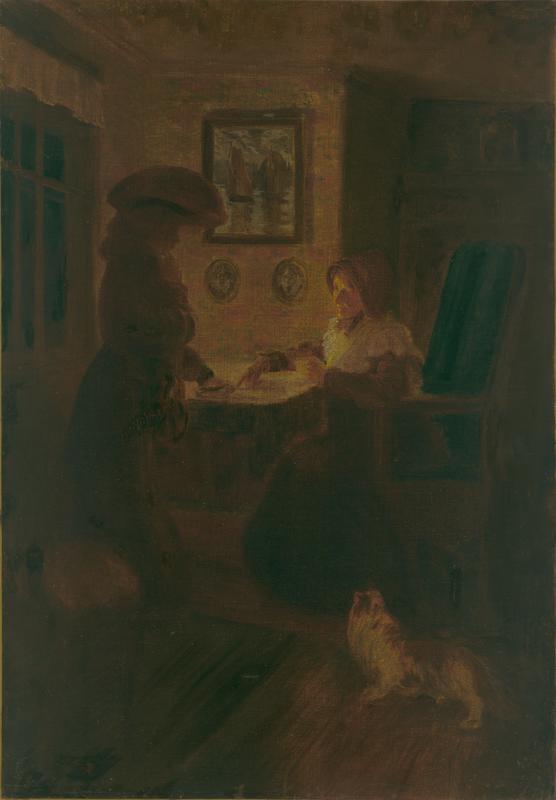
Fleischebin (1801–1868) completed this informal interior scene in 1843. The German-born artist trained in Paris at the École des beaux-arts before immigrating with his wife and four children to New Orleans in 1833. (Courtesy of the Louisiana State Museum / Louisiana Digital Library)
The board took up the issue at its next meeting, where it was decided that The Collection would no longer use Hudson’s services. Fearing a lawsuit, however, the board decided not to publicly censor her, citing an existing policy against divulging the names of specific appraisers or conservators. “It was a very small town,” Bonner says of the local fine art community at the time.
Finally, there was the question of what to do about the painting. It had already sat at Hudson’s studio for nearly two years, and now The Collection faced further delays and damage if it were to pursue a restoration. Another consideration was that, at the time, The Collection had no other portrait showing a free person of color to share with its visitors. Though the lace collar and bow were gone, Hudson had left the sitter’s jewelry intact: a fine brooch at her collar and a delicate earring. These details and the gold tignon still would serve to identify the sitter as a free woman of color. THNOC decided to exhibit the painting as-is.
And so, after more than a century in private hands, the Fleischbein portrait entered the public realm. From 1988 through the mid-2010s THNOC exhibited it regularly, but “with no commentary that it had been altered through conservation,” an internal report states. At some point, The Collection began using Jordan’s unconfirmed identification, Betsy, as the formal title of the painting. In 2014, Hudson passed away.
In her thesis, Momoh, who often refers to the painting as Not-Betsy, describes the portrait’s reach beyond The Collection: “Not-Betsy has graced the covers of monographs on the history of the Crescent City and romance novels about the American quadroon. A much larger-than-life wall graphic depicting the portrait remains on display at the Smithsonian’s National Museum of African American History and Culture. HNOC sold copies of the portrait in their gift shop and the painting itself prominently graced their walls for over 30 years.”
But, with the damage done and the story hidden, the painting and its interpretation were incomplete—a half-truth. “We knew what it was, that the painting as displayed was not representative of its original state, but we did not succeed in sharing that with the public,” says Hammer. “Sometimes we did, through visitor interactions with our staff, but it wasn’t shared in the same way every time, as with a fully conceived, written interpretation. That became a problem.”
A new chapter
If anyone at THNOC knows about the power of storytelling, it’s the staff of the Visitor Services department. Every day, they watch guests walk through the galleries, field their questions, and hear their conversations. They know that people want a narrative, not just artifacts and artworks.
The Fleischbein portrait, which currently bears the descriptive title “Portrait of a free woman of color,” is a rare painting made rarer by its mystery. Who was this woman? As viewers gaze at the sitter, following the folds of her tignon, the upward curve of her lips, the placidity of her mien, the flame of interest sparks to life. Such is the power of art to tell compelling history, but for 30 years The Collection provided no narrative beyond what individual docents were able or willing to share.
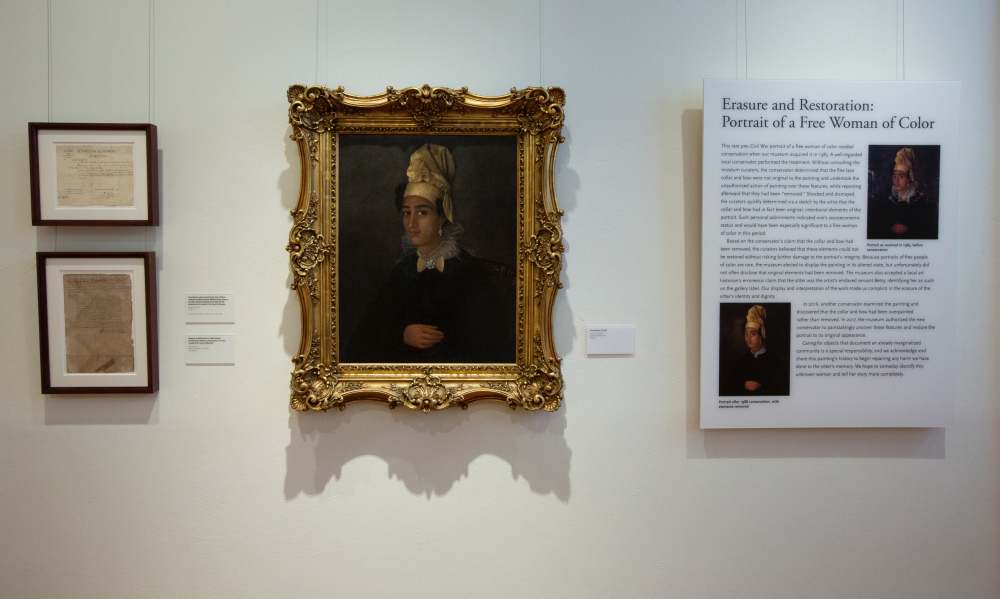
The restored painting is now hangs on view in the French Quarter Galleries at 520 Royal Street. (Photograph by Keely Merritt, THNOC head of photography)
The reinstallation of the restored painting and the accompanying text panel provided an important testing ground for new, more inclusive ways of telling the stories of our holdings. Starting in October 2020, Chief Curator Jason Wiese, working with Conservation Coordinator Maclyn Le Bourgeois Hickey and Senior Editor Mary M. Garsaud, collaborated with THNOC’s IDEA committee—a cross-departmental group of staff committed to implementing principles related to inclusion, diversity, equity, and accessibility—to inform gallery viewers honestly about the painting’s past. One year later, with the reopening of the French Quarter Galleries at 520 Royal Street, THNOC unveiled the painting and panel.
Through this effort, THNOC has learned that telling uncomfortable stories not only brings dignity to the art and its historical subjects—it also makes for a better visitor experience. “I’m walking through the galleries constantly and specifically paying attention to that space. People not only stop—almost all of them do and really spend time with that panel,” says Visitor Services Assistant Dhani Adomaitis.
According to Visitor Services Assistant Winston Ho, who specializes in local Chinese American history, obscured or tangled narratives behind historical artworks are not as uncommon as people might think. “I work in Chinese American history and have the same problem constantly,” Ho says. “What you see with that painting, it happens all the time. So for us to talk about it, it’s been a positive.”
In Momoh’s current work as the Constance E. Clayton Curatorial Fellow at the Philadelphia Museum of Art, she has been reinterpreting items related to the abolitionist movement, which, despite their liberal underpinnings, often traded in racist imagery and tropes. “Institutions in the North are wrestling with racism within the abolition movement,” she says. “So this subject, it’s affecting not just institutions in the South, but everywhere.”
Just as bias-free interpretation has become a hot topic among institutions, the subject has proven to be a great icebreaker among museumgoers. “I’ve had probably dozens of comments from people thanking us, and a lot of great discussions about it there,” Adomaitis says. “It’s milking conversation between different people, consistently—and all ages, all demographics.”
This story also appears in the summer 2022 issue of THNOC Quarterly, which is available by mail to THNOC members.

